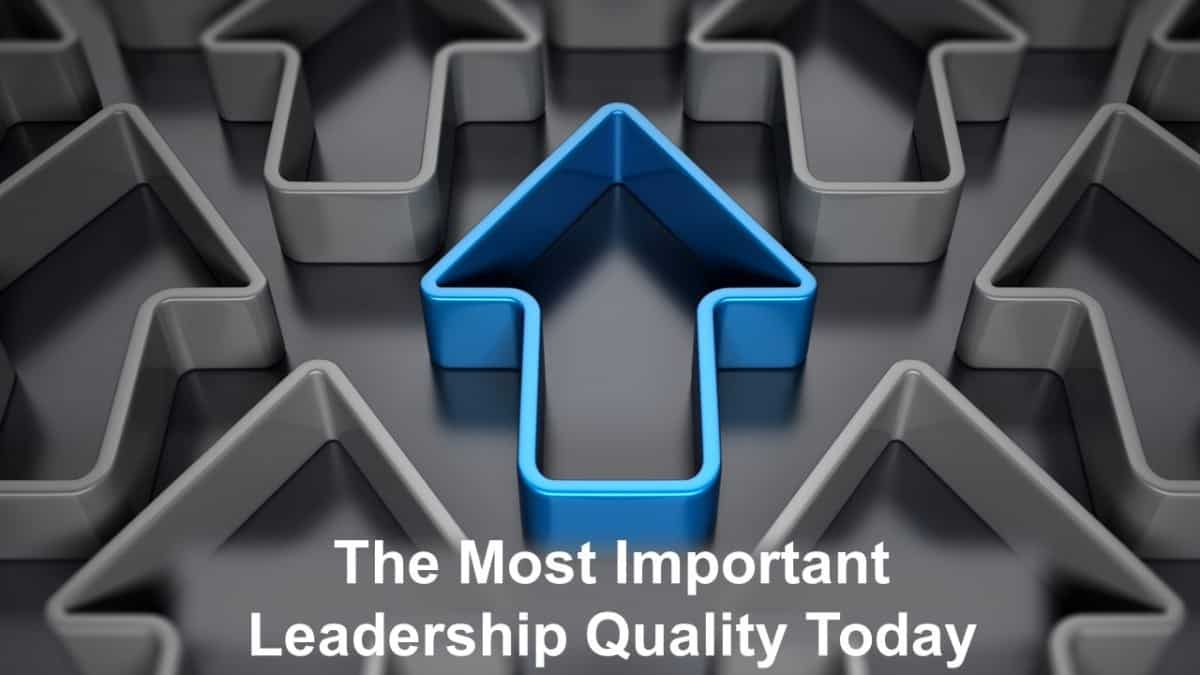Share:
Mark S. Babbitt, Contributor
S. Chris Edmonds, Contributor

For several decades, the world of work settled for Industrial Age-style leadership. More recently, we’ve begun replacing autocratic, command-and-control practices with more human-centered behaviors.
However, while any improvement is welcome (and well past due), we still struggle to identify the single-most important leadership quality in the workplace today.
Yes, we hear a lot about empathy, adaptability, and vulnerability as sought-after leadership traits, along with active listening, relationship building, and self-awareness. Especially over the last decade, some leadership traits have become so commonly discussed they’ve become buzzwords: mindfulness, authenticity, and transparency, to name a few.
We agree: Each of these traits deserves to be in most top ten lists. But, in our work, we’ve found that sometimes what sets up a leader for success is something they stubbornly do not do. Something many of their predecessors (and even mentors) have done for generations. Not that these leaders plan to fail—but because that is how society taught them to lead.
The one thing today’s leaders cannot do if they want to excel? They can’t focus exclusively on…
Results.
The most important leadership quality today isn’t results, though many leaders continue to focus primarily on results as a measure of their effectiveness. To lead your team to success in today’s workplace, you have to be a culture-first leader who fosters a positive employee experience for all team members.
This article will explore how culture-first leadership is the key to success as we look to the future of leadership.
The Trouble of Focusing Exclusively on Results: An All-Too-Common Case Study
What is the problem with leaders driven only by results? Let us answer that question by describing a scenario that occurs far too often—yes, even in today’s more empathetic workplaces run by authentic, transparent leaders.
Let us introduce you to “John.”
John has been the top salesperson at XYZ LLC for nearly six years. Each quarter, sales management and C-suite executives can count on John’s take-no-prisoners approach and do-whatever-it-takes attitude. He will close the biggest deals and consistently bring in the most revenue.
John, as one might imagine, is a confident beast. That confidence (or is it arrogance?) leads John to blurt out insensitive comments; after all, management has empowered him to say “what everyone else was already thinking.”
While in the breakroom, it’s John who tells the off-color, perhaps even racist, jokes. While on the sales floor, John is entirely comfortable standing too close to a female employee while asking her personal questions.
It’s also John who “calls it like it is” when disrespectfully raging about what he considers poor decisions by the marketing team or management.
No, he couldn’t murder a person on Fifth Avenue and get away with it. But, over the years, John has repeatedly pushed the boundaries of respectful behaviors, and he has never been held wholly accountable. When management reluctantly approaches John about making a fellow employee feel uncomfortable, the conversation often starts with, “I know you were just joking, but…”
Even worse, because John has been the top salesperson for 17 consecutive quarters, he is now first in line for the Vice President of Sales position. Because the CEO only cares about results, moving John into a management position seems completely natural. “The boy has earned it,” one of the good ol’ boys in the C-suite will say (probably loudly).
Because in the end, John is the top salesperson. And at XYZ LLC, only results matter.
The Problem with Too Many (and All-Too-Influential) Johns
Once on the executive team, John will do what many Johns before him have done. He’ll hire more Johns that look, think, act—and probably sell—just like him. And for the non-Johns at XYZ, this “Oh, he’s just one guy” problem quickly becomes a tsunami of Johns and invariably leads to a toxic company culture.
Because of the Johns, employees, especially female contributors and people of color, no longer expect to be treated with respect. They know they won’t receive affirmation for their work because management seems only to recognize the John types at XYZ.
Even worse, though they know the company would benefit greatly from a more diverse, more human-centered presence on the executive team—the hiring team won’t seriously consider them. Why? Because the Johns get all the promotions.
So what happens to the non-Johns?
They work so hard to get noticed, they burn out. They fail so often to prove their worth that they eventually quit trying. Sometimes after much heartache, hair-pulling, and eroding stomach lining, they quit.
Good people leave. And all that’s left at XYZ LLC is an office full of Johns. The company culture soon goes the way of early Uber (perhaps the original “bro culture”). Gender pay gaps become the norm, hiring non-white applicants happens rarely, and the company’s ‘About Us’ and ‘Our Team’ pages are white-washed.
No, Diversity is NOT the Most Important Leadership Quality (But it is Close)
By now, you may think we’re leaning toward the building of a diverse, equitable, and inclusive team as today’s number one leadership trait. And if you quit reading right now and made a difference in that crucial area within your sphere of influence, we’d be happy.
However, as many organizations have experienced over the last two or three decades, a stronger focus on DEI (diversity, equity, and inclusion) issues isn’t enough. Why?
- Because until we have a company culture where we don’t tolerate “bro” or “good ol’ boy” behaviors, it’s impossible to sustain a diverse workforce.
- When leaders don’t show people like John the door when they impose their self-proclaimed alpha-male status on coworkers, we can’t claim to be equitable.
- And if people aren’t held accountable for dehumanizing others, we can’t even talk about being inclusive.
Before we can begin working toward a culture where every human being experiences purposeful, fulfilling interactions—where they are respected and validated for their ideas, efforts, and contributions, daily—we must focus first on company culture.
And not just from a DEI perspective. In fact, we’ve seen significant initiatives—digital transformation, product innovations, employee engagement, and so many more, including post-pandemic hiring and retention programs—fail only because the leaders pushing those transformations failed to ask an important question first:
Is our company culture strong enough to serve as the foundation for this change?
Too often, the answer is no. Far too often, leaders come to this conclusion too late.
This brings us full circle to the most important leadership quality today…
Today’s Best Leaders are Culture-First Thinkers
No, we’re not talking about nap pods and ping-pong tables. Like most employees, once the novelty wears off, we don’t care about free food, snacks, or on-site laundry services.
Those are perks. They are NOT culture.
Culture, simply put, is what it’s like—really like—to work at a company. It isn’t what the ‘About Us’ page says. Culture is certainly not what the first few sentences of every job description says. Nor is it what a CEO recites from memory when trying to say all the right things in front of the board of directors.
Instead, culture is all about how we treat people in the workplace.
How we treat employees impacts how they feel about work, from the time they get up to go to work to what they think about before falling asleep that night. Throughout the day, the quality of your company culture is reflected in their body language—and on their faces.
Are they excited to be here? Do they believe the mission matters? As they help accomplish that mission, do they know their work matters? Are their voices heard? Do they genuinely have the same opportunities as every other human in the building? Do they consider their manager a mentor?
Are they doing good work, with good people, for a good reason?
Until the answers to many of those questions are consistently a “yes” (which means there are very few Johns hanging around), any “transformation” is unnecessarily complex at best. And perhaps impossible.
After all, how can you expect traction on any change effort if your company culture sucks? How can you change the status quo if no one with any long-term potential wants to work at your company?
And if you tolerate the sexist, racist, inappropriate behaviors of all those Johns? Your company culture sucks. Your reputation as an employer will become broadly known. And except for other Johns, no one will want to work for your company.
What Does it Mean to Be a “Culture-First” Leader?
In our book, Good Comes First: How Today’s Leaders Create an Uncompromising Company Culture That Doesn’t Suck, our foundational principle for culture-first leaders is to “equally value respect and results.”
More specifically, in a previous article for Business Leadership Today, we state that leaders must make respect the most critical element of the employee experience across the company. As we also say in that article, please note that this foundational principle is an AND statement: “respect AND results.”
That is to say that culture-first leaders can’t focus on respect and tolerate poor results. Our “John” case study shows that a leader obviously can’t focus on results while tolerating disrupting behavior.
And what happens when a culture-first leader focuses equally on creating a respectful workplace AND enables a more fulfilling, purposeful work environment to drive results:
- Employee retention and referrals improve by 25 to 40 percent.
- Employee engagement increases by 40 percent or more.
- Customer service ratings and retention levels grow by 40 percent or more.
- Results and profits increase by 35 percent or more.
The data is clear: Culture change—specifically when leaders emphasize workplace respect—positively impacts nearly every results-based business metric.
No, this transformation doesn’t happen overnight. At the same time, when culture-first leaders perform random acts of leadership and create contagious pockets of excellence, you’ll quickly witness tangible changes in culture. We’ve seen it happen, literally, overnight.
And in 12 to 18 months, your company culture will become a strong enough foundation on which you and your leadership team can build every other initiative.
The Four Steps (and Four Phases) of a Culture-First Leader
As we describe in Good Comes First, a culture-first leader will need to embrace four distinct phases while building an uncompromising company culture, a culture where people expect respect while they help drive results:
Discovery
Every leader must first thoroughly understand their current company culture. What is working well? What is not working? Which leaders and teams are thriving? Which are not?
Collecting this qualitative data during the ‘Discovery’ phase means starting some tough conversations and leveraging your active listening skills. However, this objective insight will shed light on what steps your leadership team must take to improve company culture dramatically.
Define
During the ‘Define’ phase, culture-first leaders will work with fellow senior leaders, managers, and internal influencers to decide what an uncompromising company culture looks and feels like in their company.
That effort starts with drafting a servant purpose (your reason for being), defining core values (and the behaviors that might demonstrate if someone is modeling those values in observable and measurable terms), and including your strategies and goals (results).
Align
In the ‘Align’ phase, a culture-first leader’s focus is to ensure all contributors, especially leaders and other role models, are aware of and have begun aligning to new culture expectations. Because you’ll state values in observable and measurable (“accountable” versus “aspirational”) terms, alignment will be apparent.
In this phase, we introduce our 360-degree Accountability model, which emphasizes modeling, coaching, measuring, celebrating, and mentoring valued behaviors.
Refine
The ‘Refine’ phase is a culture-first leader’s first opportunity to identify those contributors and teams not yet fully embracing the defined company culture. Then, by leveraging objective data collected through Values and Behaviors and the Executive Team Effectiveness surveys, a leader encourages every employee (every leader and employee, not just the Johns) to better align with the defined culture.
Sometimes, though, despite all available coaching and mentoring, alignment isn’t apparent—or possible.
What Happens When Employees Can’t Embrace Culture?
We remind culture leaders:
“Leaders build culture based on the productive, positive behaviors they reward. Leaders tear down culture based on the destructive, demeaning behaviors they tolerate.”
As you embrace the concept of culture-first leadership, keep in mind that the Johns of the world, while they produce on the results side, deconstruct your company culture on the respect side.
As many other leaders have learned, you’ll find a way to replace the lost revenue once John is gone. Unfortunately, it is much harder to repair your legacy as a leader or your company’s reputation as an employer.
And as you begin your culture change journey (so you can then gain sustainable traction with every other initiative), be sure to demonstrate all the other skills from those “Top 10 Leadership Traits” blog posts.
Even after you’ve embraced your role as a culture-first leader, which includes you serving as Chief Role Model for every observable, measurable valued behavior, this process will challenge you.
So, as you replace all the Johns with good people who care enough to show every contributor the respect they deserve, you’ll need to exhibit each of those Top 10 skills—buzzwords or not.

Mark S. Babbitt is President of WorqIQ, a firm that helps organizations understand leadership’s impact on culture, the company’s collective level of Workplace Intelligence (WQ), and what “good” means to them. He is also the author of the best-selling book, Good Comes First.

S. Chris Edmonds is a speaker, executive consultant, and founder of The Purposeful Culture Group. He’s also the author of two Amazon best sellers: Good Comes First and The Culture Engine.


